by Kaycee Doherty, AmeriCorps Cape Cod Member 2024-2025
Sparrows are a common but often frustrating bird to identify for new birders. These little brown birds often look very similar and take a lot of practice and attention to detail to tell apart. Despite this, I often find sparrows to be some of my most favorite birds to identify. Their challenging nature makes finally understanding them that much more rewarding. They’re also everywhere, which means plenty of opportunities to practice.
Here are a few of the sparrows you can find throughout the year on Cape Cod and around the refuge, perfect for sharpening your ID skills.
Spring: Chipping Sparrow
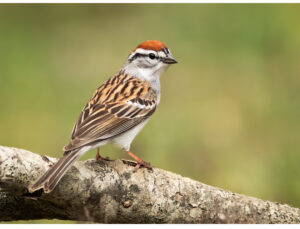
These birds are especially common during the warmer months, arriving in the spring to breed and raising their young through the summer. On Cape Cod, Chipping Sparrows are often seen flitting through open woodlands, grassy yards, and shrub-dotted dunes. They’re easy to recognize thanks to their bright chestnut cap, crisp white underparts, and a distinctive black eye-line that cuts across their otherwise pale face. Their soft trills, a rapid, dry-sounding song, are a familiar backdrop in many Cape neighborhoods during the spring and early summer. They’ll readily nest in both natural woodlands and developed areas, making them one of the more human-tolerant species.
Summer: Seaside and Saltmarsh Sparrow
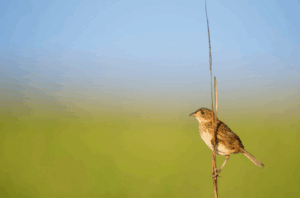
In the summer, two of the most significant sparrows on the Cape are the Seaside and Saltmarsh Sparrow. Both species arrive around May to breed in coastal saltmarsh habitats. While Seaside Sparrows can be found along much of the Cape’s shoreline, Saltmarsh Sparrows are more localized, with breeding populations primarily on the Outer Cape in places like Wellfleet Harbor and Nauset Marsh.
Saltmarsh sparrows breed on the Outer Cape in Wellfleet Harbor and Nauset Marsh, both places at risk from sea level rise and invasive species. Their nests, built on the salt marshes they are named after, are often flooded or destroyed by human activity. They are the single most endangered species on Cape Cod because of this habitat loss.
Seaside Sparrows are very similar to their saltmarsh counterparts, with a similar appearance and song. Due to the secretive nature of these birds it can be most effective to identify them through their songs. Both are secretive and often stay low in the vegetation, so identifying them by sound is often the most effective method. When seen, Seaside Sparrows tend to be slightly larger and darker, with less prominent streaking.
Fall: Song Sparrow
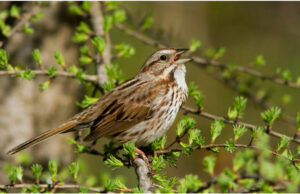
Song Sparrows are one of the most widespread and familiar birds on Cape Cod. A long time ago, they used to be only summer residents, but since the 1900’s, people have begun seeing them year round, although the winter population is still noticeably smaller. Males begin singing early in the spring, often from high perches, with a song that starts with a few clear notes followed by a buzzy trill. These songs vary between individuals but serve the same purpose: to mark territory and attract a mate.
On the refuge, they can be found in a variety of habitats— marsh edges, shrubland, woodland edges, and even in gardens or along trails. Their streaky brown plumage and central dark chest spot help with camouflage, but their persistent singing often gives them away. Song Sparrows usually nest low in dense vegetation and may raise two or more broods through the spring and summer.
Winter: Fox Sparrow
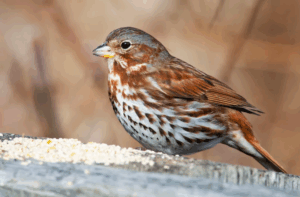
Cape Cod marks the northern edge of the Fox Sparrow’s wintering range, and while many individuals are seen passing through during fall and spring migration, a notable number remain through the colder months. These large, heavy-bodied sparrows are most often found in dense thickets, especially near the edges of woodlands or in overgrown areas with plenty of cover.
Fox Sparrows are striking in appearance, with bold reddish-brown streaks on a white chest, a grayish face, and a strong, slightly curved bill. They forage mostly on the ground, uncovering seeds and insects hidden beneath leaf litter or snow. Though generally shy and quick to take cover, they may be seen visiting feeders, especially in quiet areas with good shrub cover nearby.
An Invasive Year-Rounder: House Sparrow
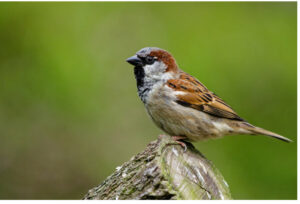
Another sparrow seen year-round on Cape Cod is the House Sparrow. Unfortunately, this bird is an introduced invasive species. Despite originating in the Middle East as agriculture spread in early human civilization, House Sparrows made a home in Eurasia and parts of Northern Africa. House sparrows were introduced to the United States for the first time in 1851 in Brooklyn, New York, to control insect pest populations in trees. It is now one of the most abundant birds on the continent.
They are known for evicting other cavity nesting birds, destroying the eggs and nestlings and even adults of other bird species. They are territorial and aggressive, often seen dominating feeders. To prevent these sparrows from overtaking your feeders and homes put up for other birds, there are several things you can do. Firstly, don’t throw breadcrumbs and baked goods outside, and avoid cheaper seed mixes, such as those with a high percentage of millet, wheat, and cracked corn. In addition, make sure openings for bird houses are large enough for your target species, whilst being too small for most House Sparrows to fit in. Most articles suggest a hole with openings less than 1 1/8- inch in diameter.
Whether you’re just starting to learn sparrows or have been watching them for years, there’s always more to notice. From the familiar Song Sparrow singing from a backyard shrub to the secretive Saltmarsh Sparrow nesting deep in a coastal marsh, each species offers a chance to sharpen your observation skills and connect more deeply with the local landscape. Sparrows may seem challenging at first, but with patience and practice, they become some of the most rewarding birds to know—offering not just an identification puzzle, but a deeper appreciation for the habitats that support them.
